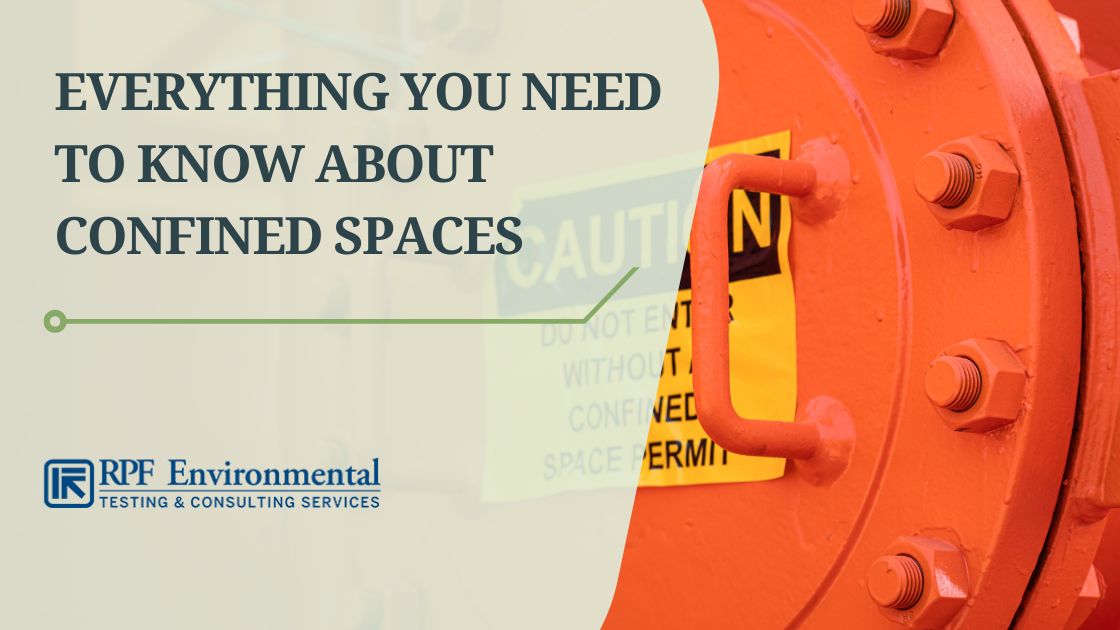Employees entering confined spaces to perform maintenance work or rescue operations, especially in the construction industry, can get exposed to unexpected hazards. These include toxic substances, asphyxiations, explosions, and electrocutions.
And since confined spaces have limited or restricted means for entry or exit, workers or rescuers could die during the process. This makes understanding confined spaces and following OSHA standards, including the provision of worker training, critical to prevent workplace fatalities and serious injuries.

RPF Environmental’s EH&S training courses include confined space training programs and other workplace safety courses in Illinois, Indiana, Maine, New Hampshire, Massachusetts, and across the country. Call us now for further details!
What Are Confined Spaces & How Do You Know if You Are Dealing With One?
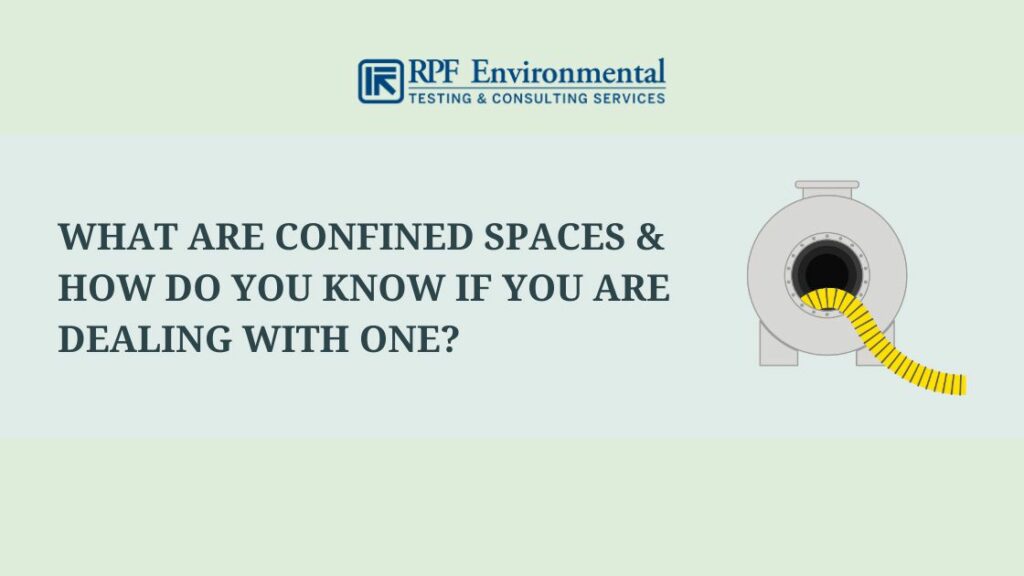
Contrary to popular belief, confined spaces don’t necessarily mean small spaces.
General Definition of a Confined Space
According to OSHA’s 29 CFR 1910.146 standard (Permit-required confined spaces), a confined space is a space that meets all of the following conditions:
- Is large enough for an employee to bodily enter and perform assigned work – It is impossible to get trapped inside a space if you can’t fit your body in it.
- Has limited or restricted means for entry or exit – It is difficult to enter or exit confined spaces which makes maintenance or rescue operations hard.
- Is not designed for continuous employee occupancy – Confined spaces are not intended to accommodate people (workers can’t enter them and perform work on a routine basis because they were made for other things like sewage, degreasers, etc.)
NOTE: The definition of a confined space will vary between jurisdictions and will depend on other factors like the industry type and where you live. The classification of the confined space will also depend on the associated hazards’ nature and severity.
Types of Confined Spaces
Confined spaces are categorized into two major groups: permit and non-permit spaces:
Permit-Required Confined Space (PRCS) or Permit Space
Permit spaces are the most hazardous types of confined spaces that require rigorous planning along with qualified and trained personnel to complete a written safety checklist before entering the space. This ensures the removal of hazards from the space before any work inside is performed.
According to OSHA’s definition of a permit space, it can have one or more of the following characteristics in addition to the general criteria above:
- Has a hazardous atmosphere or could contain one (e.g. storage tanks, manholes)
- Contains materials that have the potential of engulfing an entrant (e.g. silos)
- Has walls converging inwardly or floors sloping downward that lead to smaller sections which can lead to entrapment or asphyxiation (e.g. augers)
- Has other recognized serious health and safety hazards (e.g. temperature extremes, electrocution, radiation)
NOTE: Permit spaces can be reclassified as non-permit under the procedures specified in section 1910.146(c)(7).
Examples of Permit Confined Spaces
Below are a few examples of confined spaces:
- Storage tanks
- Process vessels
- Reaction vessels
- Storage bins
- Silos
- Pits
- Vaults
- Hoppers
- Manholes
- Tunnels
- Pipelines
- Ductwork
- Equipment housings
- Ship compartments
- Degreasers
- Boilers
- Sewers
Non-Permit Confined Spaces
OSHA defined non-permit confined spaces as:
“…A confined space that does not contain or, with respect to atmospheric hazards, have the potential to contain any hazard capable of causing death or serious physical harm.” – OSHA, Permit-required confined spaces
Non-permit confined spaces do not require the completion of a written safety checklist before you can start work in them because they don’t contain foreseeable hazards.
Examples of Non-Permit Confined Spaces
- Utility closets
- Storage rooms
- Machinery cabinets
- Drop ceilings
NOTE: When changes have been made to non-permit spaces (configuration or use), they should be reevaluated if they have the potential to harm entrants and reclassified as permit spaces.
Common Myths About Confined Spaces
Below are some of the common misconceptions about confined spaces and the truths:
- They are enclosed and small – Humans can fit inside them
- Oxygen levels ranging from 19.5% to 23% are safe – Harmful substances may be displacing oxygen in the air and are not necessarily safe
- It is safe as long as you don’t enter the confined space – You may be inhaling hazardous substances coming from the confined space and working outside spaces containing flammable vapors can cause massive explosions
OSHA Confined Space Standards: Entry Permit Requirements, Hazard Control, Rescue Procedures, & Training
Entry into confined spaces must follow OSHA’s standards to effectively control hazards and ensure worker safety as well as avoid violations. The standard for the general industry includes developing and implementing a written permit-required confined space (PRCS) program, controlling hazards, providing worker training, and others.
NOTE: Since confined space regulations may vary depending on the industry and jurisdiction, make sure that you review specific regulations that are applicable to the needs of your workplace.
Confined Space Entry Permit Requirements
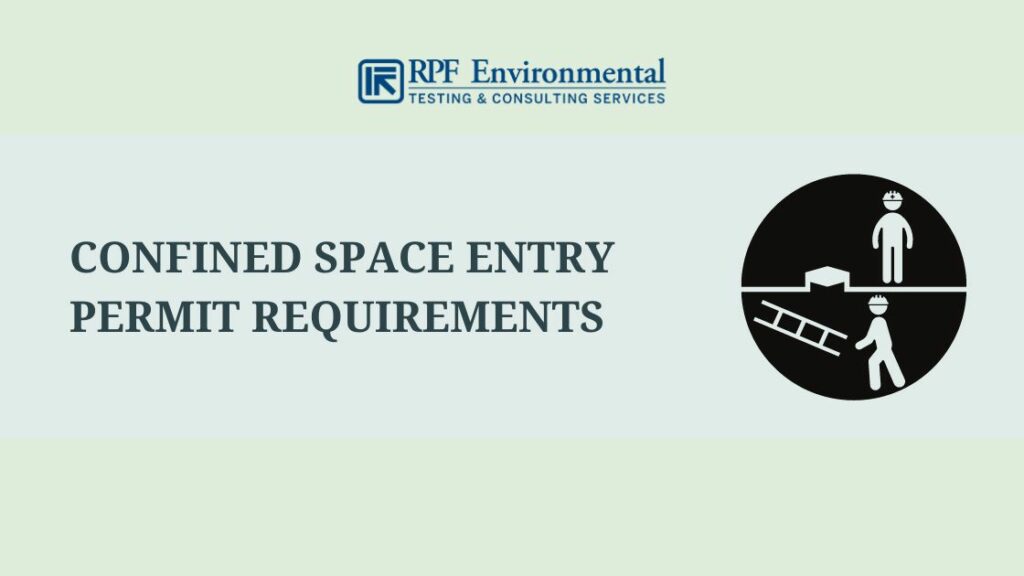
Below are the general requirements before entering a permit space:
- The employer must evaluate if spaces in their workplace are permit spaces by following OSHA’s PRCS Decision Flow Chart. If yes, they must inform exposed employees regarding the existence, hazards, and location of the permit spaces by posting danger signs like “DANGER—PERMIT-REQUIRED CONFINED SPACE—AUTHORIZED ENTRANTS ONLY”.
- If the permit spaces will be entered, the employer is required to develop a written PRCS program. Otherwise, the employer will have to take effective measures that will prevent employees from entering PRCSs.
Written Permit-Required Confined Space Program Requirements
The permit-required confined spaces standard requires employers to develop written PRCS programs in accordance with section 1910.146(d) which includes the following:
- Implementing measures needed to prevent entry by unauthorized personnel
- Identifying and evaluating hazards before entry
- Developing and implementing procedures and practices for controlling and eliminating hazards
- Testing atmospheric conditions before entry and monitoring them during entry
- Providing and maintaining the necessary equipment to employees at no cost and ensuring that they use them properly
- Evaluating conditions in the space when conducting entry operations
- Designate roles and identify the duties of each employee including the provision of training
- Stationing at least one attendant outside the space
- Developing and implementing procedures for rescue and emergency operations including the prevention of unauthorized rescues
- Establishing and implementing systems for preparing, issuing, using, and canceling entry permits
- Reviewing entry operations and revising the permit-required confined space entry program as necessary to correct deficiencies
For the duties of each employee who will be involved in the confined space entry, they are specified in the following sections of the permit space standard:
- 1910.146(h): Duties of authorized entrants
- 1910.146(i): Duties of attendants
- 1910.146(j): Duties of entry supervisors
Requirements When Entering Permit Spaces
Below is the required process to be followed when evaluating conditions in permit spaces for entry operations:
- Testing for the acceptability of the permit space conditions before entry
- Continuously monitoring entry conditions where authorized employees are working
- Testing for atmospheric hazards in the following order: (1) oxygen, (2) combustible gases and vapors, and (3) toxic gases and vapors
As you might have noticed, the above procedures are done before actually entering permit spaces. Upon completion of the procedures and the confirmation of the entry supervisor that conditions are acceptable, the permit will be signed to authorize entry.
Written Confined Space Entry Permit Requirements
As for the entry permit, it shall include the following details as specified in section 1910.146(f) of the standard:
- Permit space name
- Entry purpose
- Entry date and duration
- Authorized entrants, attendants, and entry supervisors
- Identified hazards
- Measures for isolating the space as well as eliminating and controlling hazards including lockout/tagout procedures
- Acceptable entry conditions
- Test results
- The tester’s initials/signature
- Rescue & emergency services to summon and ways to contact them
- Communication procedures to maintain contact
- Equipment to be provided
- Additional permits
- Other necessary information to ensure worker safety
You can find an example of a confined space entry permit by OSHA here along with the specific steps that you should take before, during, and after the entry.
Cancelling Entry Permits
Entry supervisors should cancel PRCS entry requirements when:
- The work being performed in the PRCS is completed
- New conditions have emerged
Also, canceled permits must be retained for at least one year with any new condition that has arisen noted on them. These will be used to review and revise the PRCS program as necessary to ensure the protection of employees from all space hazards.
Confined Space Hazards & Control
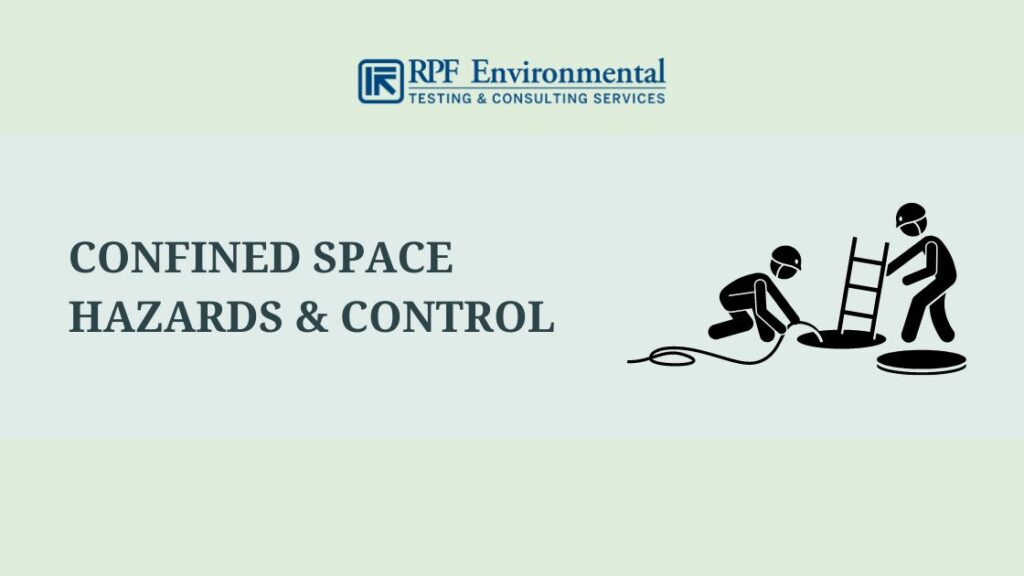
Atmospheric hazards are the popularly known types of hazards in confined spaces. But, there are two classifications of confined space hazards mentioned by OSHA: atmospheric and physical.
1. Atmospheric Hazards
OSHA defined a hazardous atmosphere as one that may cause injury, incapacitation, death, impairment of self-rescue ability, or acute illness.
Examples of atmospheric hazards include:
- Toxic Gases (common types in confined spaces include solvents, carbon monoxide, and hydrogen sulfide)
- Flammable Atmospheres
- Oxygen Displacement
- Oxygen Deficiencies (<19.5% concentration)
- Oxygen-Enriched Atmospheres (>23.5% concentration)
- Chemical vapors
- Dust
- Welding fumes
- Mists
- Fogs
In addition, some products and machines that can cause atmospheric hazards include:
- Generators that create exhaust fumes
- Toxic fumes produced by painting in confined spaces
2. Physical Hazards
Physical hazards are common in spaces where workers often work alone. This, along with extreme temperature conditions and poor lighting, increases the risks of injury.
Examples of physical hazards include:
- Explosives
- Radiation
- Engulfment
- Excessive noise
- Temperature extremes
- Sloping and slippery surfaces
- Obstructions
- Falling objects
- Rotating or moving equipment
- Corroded ladder rungs
- Surfaces converging inwardly
- Chemicals that can cause serious damage or even death upon eye or skin contact
Controlling Hazards
Employers should have conducted a hazard assessment or analysis to determine what hazards are present or may be present so they can be addressed before entry. OSHA requires employers to establish procedures for eliminating or controlling hazards when developing a written PRCS program. These include:
- Specifying acceptable conditions for entry
- Permit space isolation
- Providing barriers (e.g. vehicle and pedestrian barriers) for protection against external hazards
- Ventilating, flushing, purging, or inerting the space to control/eliminate atmospheric hazards
- Verifying the acceptability of the conditions in the permit space throughout the duration of the entry
Employers should also provide the necessary equipment for safe entry which includes:
- Personal protective equipment
- Lighting, communications, ventilation, testing, and monitoring equipment
- Shields and barriers
- Ladders
- Retrieval devices
- Alarm systems
- Rescue equipment
Confined Space Rescue & Emergency Procedures [1910.146(k)]
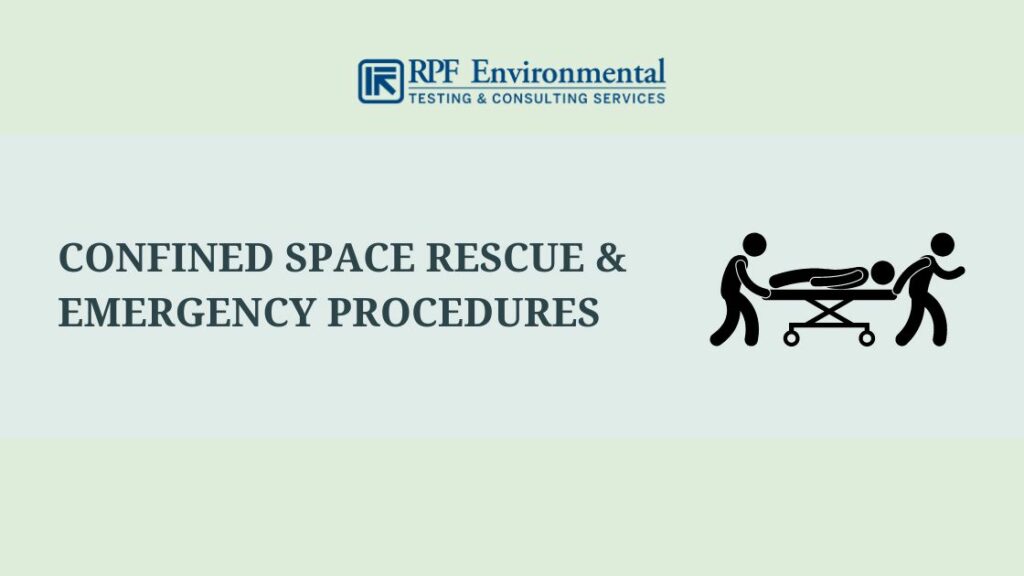
Aside from the failure to identify and control confined space hazards, inadequate emergency response is another factor that can lead to fatalities in confined spaces.
The standard requires the following:
- Employers to ensure that responders can respond to emergencies in a timely manner
- Employers to provide PPE and rescue equipment as well as training to rescuers
- Rescuers to be trained in CPR, first aid, and how to perform their assigned rescue duties as well as receive the authorized entrant’s training
- For at least one rescue team member to be certified in CPR and first aid
- Employers to ensure that affected employees practice performing permit space rescues yearly
- Employers to provide access to permit spaces for practice rescue exercises
- For rescuers to be informed about permit space hazards
Confined Space Worker Training [1910.146(g)]
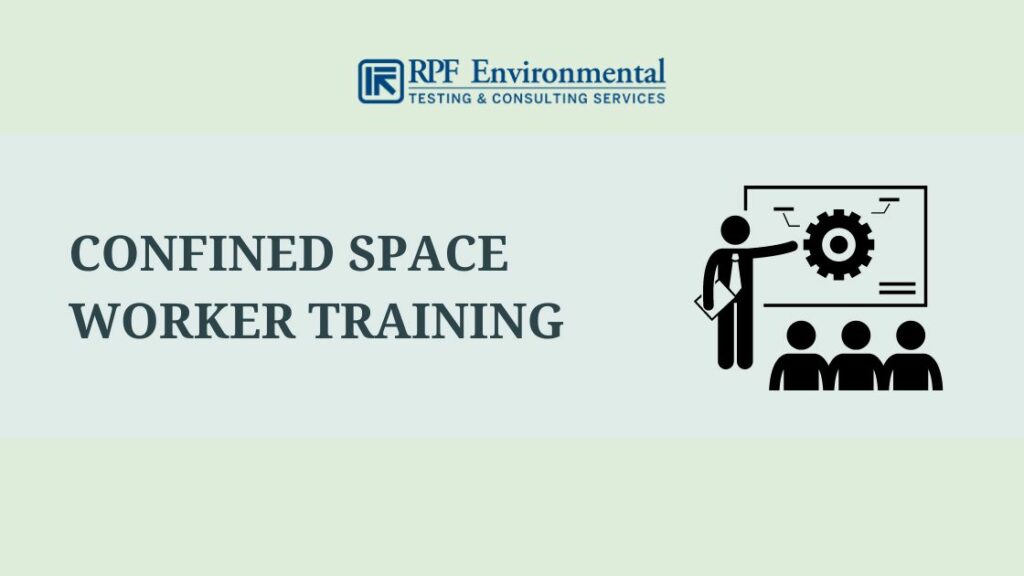
OSHA’s confined space training requires employers to provide appropriate training to all employees who will be working in permit spaces before the entry operation. Affected employees must be equipped with the required skills, knowledge, and understanding to perform their assigned duties safely. Aside from ensuring worker safety, providing training can also help employers protect their businesses from legal and financial issues.
Moreover, the following conditions will require additional training:
- When there is a change of job duties or in the PRCS program
- New hazards have emerged in the entry operation
- There are deficiencies or inadequacies in an employee’s job performance
The employer shall also certify the completion of the required training and written records of these completed trainings must be kept. The records must contain the:
- Name of the employee
- The trainers’ initials or signatures
- Training dates
Confined Space Training Outline
Some of the key topics included in confined space training are:
- Definitions associated with confined spaces
- Characteristics of a permit-required confined space
- Categories of confined spaces
- Identifying employee duties
- Employer responsibilities
- Major components of confined space programs
- Confined space hazards (physical and atmospheric)
- Hazard control and elimination (e.g. using lockout/tagout procedures)
- Atmospheric testing & ventilation
- Training & employee participation
- Confined space rescue procedures
- Employee rights and responsibilities
Confined Spaces in Construction Sites
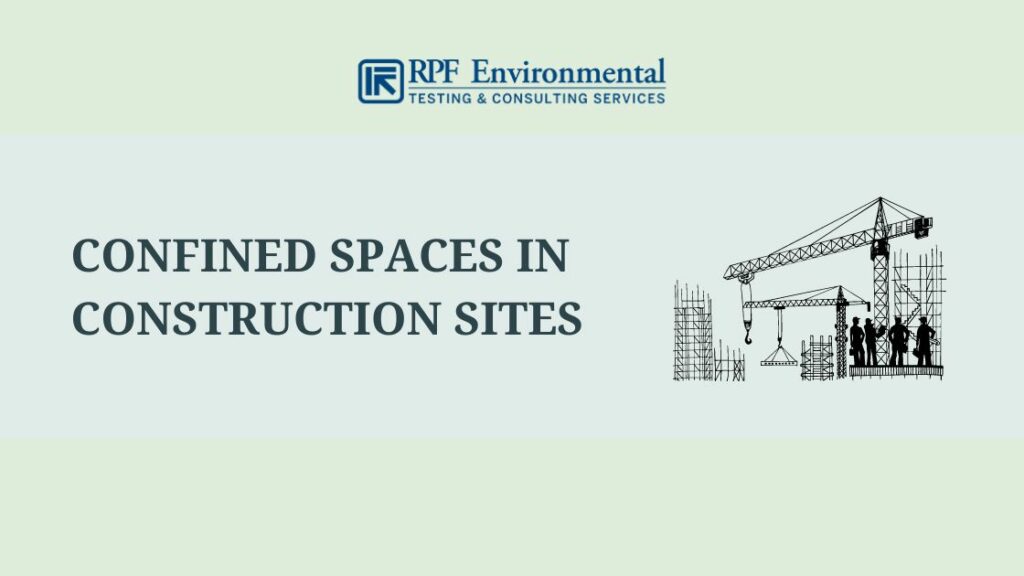
The construction industry basically followed the confined space regulations for the general industry prior to the issuance of the final rule for confined spaces in construction on May 4, 2015. However, the general industry did not consider the specific hazards in construction sites. On the other hand, the final rule included hazards in construction pits along with specific requirements for reducing them.
As stated in OSHA’s frequently asked questions regarding confined spaces in construction, there are five key differences between the general industry rule and the construction rule. These requirements are for:
1. Coordinated activities for works involving multiple employers to ensure that employees working outside the confined space won’t introduce hazards into the space (e.g. carbon monoxide buildup in the space caused by a running generator near the space’s entrance)
2. Competent people to assess the worksite and identify confined spaces
3. Continuous monitoring of the atmosphere whenever possible
4. Monitoring engulfment hazards continuously (e.g. monitoring upstream water levels when performing work in storm sewers)
5. Allowing permit suspension when there are changes in the entry conditions or there are emergency evacuations
Other Things to Know About Confined Spaces
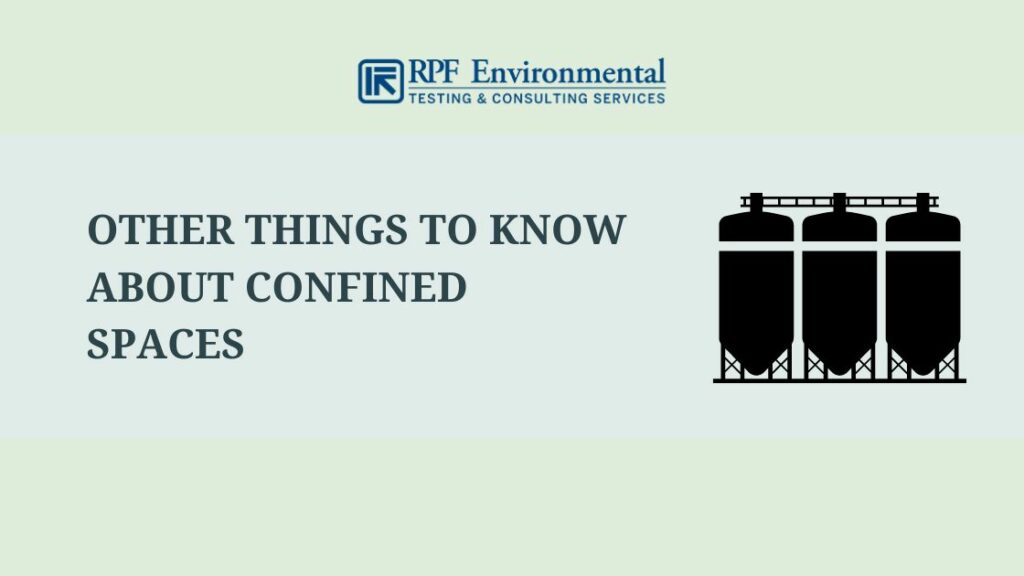
Confined Space Injuries and Fatalities Statistics
Below are the findings in the investigations conducted by the National Institute for Occupational Safety and Health (NIOSH) regarding confined space incidents:
- ~2.1 million employees enter permit-required confined spaces yearly
- 85% were supervised
- 95% were authorized by supervision
- 60% of deaths were “would-be” rescuers
- 29% of deaths were supervisors
- 15% had training
- 0% were ventilated
- 0% were tested before entry
- 0% have rescue plans
- 31% had written PRCS programs
- 0% followed the written programs
Also Read:
- Hazardous Waste Operations & Emergency Response: What is HAZWOPER?
- Examples of Lockout Tagout Procedures: A Guide to Effective LOTO Programs
- Lockout vs Tagout: Difference Between Lockout and Tagout
- E-Stop Lockout Devices: Can You Use Them in Lockout Procedures?
FAQs
Below are the three requirements for a space to be called a confined space as defined by OSHA in its permit-required confined spaces standard:
1. Large enough for employees to enter and perform work
2. Has limited or restricted entry or exit points
3. Is not intended for continuous worker occupancy
In addition, there are additional requirements that a space must meet for it to be called a permit-required confined space (PRCS) or permit space.
OSHA’s standard for confined space (29 CFR 1910.146) includes procedures for entering permit-required confined spaces (PRCSs) to protect workers in the general industry. OSHA has also issued a final rule for the construction industry (29 CFR 1926 Subpart AA). This rule includes details regarding specific hazards in construction sites and how to reduce them.
Examples of confined spaces include the following:
– Tanks
– Vessels
– Silos
– Pits
– Underground utility vaults
– Hoppers
– Manholes
– Ventilation and exhaust ducts
– Degreasers
– Tunnels
– Pipelines
– Boilers
– Sewers
– Vats
– Aircraft wings
Conclusion
Performing work in confined spaces has caused a lot of fatalities including deaths due to inadequate entry procedures. Following OSHA’s standards for the general and construction industry not only ensures the protection of workers from hazards but also compliance to avoid legal issues.
RPF Environmental offers EH&S training courses including confined space training as well as OSHA and EPA compliance consulting to reduce workplace hazards across the United States. Contact us now!

